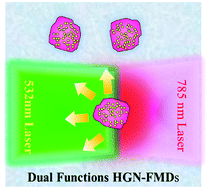Fluorescent microdiamonds conjugated with hollow gold nanoparticles as photothermal fiducial markers in tissue†
Abstract
Negatively charged nitrogen-vacancy (NV−) centers in diamonds are point defects displaying unique optical properties and biocompatibility. In this study, we characterized fluorescent microdiamonds (FMDs) and explored their potential use as fiducial markers for image-guided photothermal therapy. To exploit the excellent thermal conductivity of diamonds, we decorated the surface-functionalized FMDs with hollow gold nanoparticles (HGNs). The dual functions—fluorescent and thermal imaging—of the HGN–FMDs were performed when applying the distinct excitation laser wavelengths of the HGNs and the FMDs, respectively. The HGNs effectively absorbed the excitation near-infrared light to result in excellent light-to-heat conversion; the generated heat is transferred from 70 nm HGNs to 400 μm FMDs to provide a homogeneous and global heating effect. When we embedded five HGN–FMD particles at a depth of 2 mm in chicken breast, a temperature increase of greater than 20 °C was achievable at the site of the HGN–FMDs. Our results highlight the promise of using nitrogen vacancy-containing diamond microcrystals in conjugation with gold nanoparticles for applications involving local hyperthermia.



 Please wait while we load your content...
Please wait while we load your content...